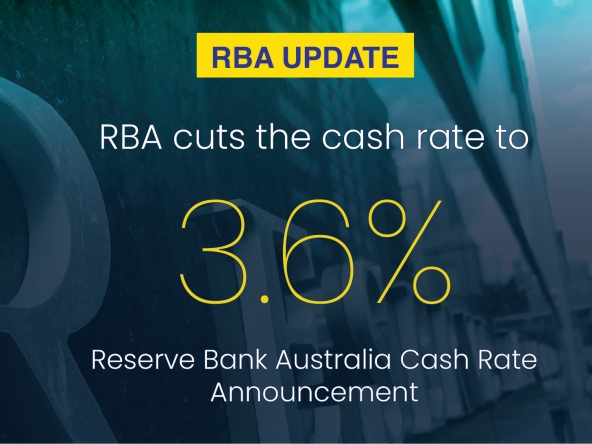

After over a decade of cutting the cash rate, the Reserve Bank of Australia (RBA) has been increasing rates almost every month since April 2022. Homeowners and would-be borrowers may be nervously wondering how high their home loan rates will go.
The big four banks have all cast their predictions for the next few years of cash rate movements. The cash rate started at 0.10% in April 2022. For the average owner-occupier paying a variable rate, your home loan rate could reach 7.11% in 2023.
Big four bank’s cash rate forecasts
- CBA: Peak of 4.10% in June 2023, then dropping to 3.35% by September 2024
- Westpac: Peak of 4.10% in June 2023, then dropping to 2.60% by December 2025
- NAB: Peak of 4.35% by November 2023, then dropping to 3.10% by February 2025
- ANZ: Peak of 4.10% in June 2023, then dropping to 3.35% by May 2025
Keep in mind that these are just predictions, and that the big banks are subject to change these forecasts.
Three of the four big banks are sticking firm to the prediction that the cash rate peaked at 4.10% in June. Only NAB economists still hold out that another hike may occur in 2023, which would lift the cash rate to 4.35%. CommBank economists have forecast that wecould see cuts to the cash rate as early as March 2024. The big four banks have predicted that the cash rate will drop to between 3.35% – 2.60% in the next two years.
How high could your mortgage interest rate rise?
Prior to the first cash rate hike, the average existing owner-occupier variable home loan rate in April 2022 was 2.86%, according to the Reserve Bank of Australia.
This is what average home loan interest rates may look like if the big four bank predictions are accurate:
Average interest rates based on big four bank cash rate predictions
| Starting Month | Average rates based on CBA forecast | Average rates based on Westpac forecast | Average rates based on NAB forecast | Average rates based on ANZ forecast |
| Apr-22 | 2.86% | 2.86% | 2.86% | 2.86% |
| May-22 | 3.11% | 3.11% | 3.11% | 3.11% |
| Jun-22 | 3.61% | 3.61% | 3.61% | 3.61% |
| Jul-22 | 4.11% | 4.11% | 4.11% | 4.11% |
| Aug-22 | 4.61% | 4.61% | 4.61% | 4.61% |
| Sep-22 | 5.11% | 5.11% | 5.11% | 5.11% |
| Oct-22 | 5.36% | 5.36% | 5.36% | 5.36% |
| Nov-22 | 5.61% | 5.61% | 5.61% | 5.61% |
| Dec-22 | 5.86% | 5.86% | 5.86% | 5.86% |
| Feb-23 | 6.11% | 6.11% | 6.11% | 6.11% |
| Mar-23 | 6.36% | 6.36% | 6.36% | 6.36% |
| Apr-23 | – | – | – | – |
| May-23 | 6.61% | 6.61% | 6.61% | 6.61% |
| Jun-23 | 6.86% | 6.86% | 6.86% | 6.86% |
| Jul-23 | – | – | – | – |
| Aug-23 | – | – | – | – |
| Sep-23 | – | – | – | – |
| Nov-23 | – | – | 7.11% | – |
| Feb-24 | – | – | – | – |
| Mar-24 | 6.61% | – | 6.86% | – |
| Jun-24 | 6.36% | – | 6.61% | – |
| Sep-24 | 6.11% | 6.61% | 6.36% | – |
| Nov-24 | – | – | – | 6.61% |
| Dec-24 | 5.86% | 6.36% | 6.11% | – |
| Feb-25 | – | 6.11% | 5.86% | 6.36% |
| Mar-25 | – | 5.86% | – | 6.11% |
| Jun-25 | – | 5.61% | – | – |
| Dec-25 | – | 5.36% | – | – |
| CASH RATE PEAK | 4.10% | 4.10% | 4.35% | 4.10% |
Source: RateCity.com.au, Big bank rate hike forecasts as of 12/09/2023.
If you are currently on a variable rate home loan, and your lender passes on these rate hikes in full, you may find your home loan repayments become significantly more expensive. If you are still on a fixed rate home loan from the low-rate era, chances are that when your loan term ends you’ll be reverted to a much higher interest rate.
How high could your mortgage repayments rise?
RateCity has crunched the numbers on how these rate hikes could impact repayments on a 25-year, $500,000 home loan.
Assuming that your lender passes on every single cash rate hike in full to your home loan as per NAB’s predictions, and that you are currently repaying a variable rate loan, you may find that your monthly repayments are $1,234 more expensive in 2023 compared to April 2022.
How much more you may pay on your home loan in 2023
| Home loan | Monthly repayments |
| Average rate in April 2022 – 2.86% | $2,335 |
| Forecast average rate in 2023 – 7.11% | $3,569 |
| Difference | $1,234 |
Source: RBA average owner-occupier variable rate for existing customers, April 2022. RateCity.com.au. Note: Based on a 25-year, $500k home loan, comparing repayments with RBA average rate in April of 2.86% versus a 7.11% interest rate from NAB’s predicted cash rate peak of 4.35% in 2023. Does not factor in fees.
This is a significant amount for homeowners to find within their already strained household budgets – the equivalent of buying a new iPhone every month. Homeowners may want to take action as soon as possible to accommodate higher repayments, including:
- Making extra repaymentsto chip away at your loan principal;
- Paying into an offset account or redraw facilityto help reduce your interest charges; and
- Refinancingto a lower-rate lender if it suits your financial needs and budget.
Article Source: RateCity



